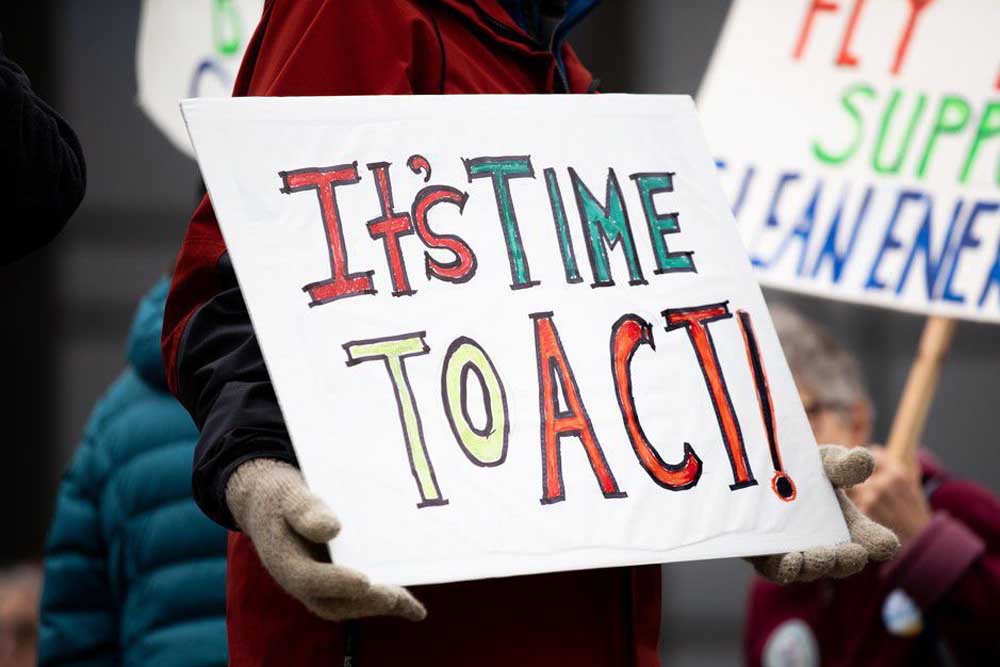Oregon cap-and-trade bill moves forward amid rising tensions
Published 10:15 am Friday, February 14, 2020

- People gather on the steps of the Oregon Capitol in Salem for a rally for climate action on Feb. 11, 2020.
SALEM — With Republicans declaring “conspiracy,” a Senate committee on Thursday moved a signature climate change bill a step closer to passage.
By a 3-2 vote, Democrats on the Senate Environment and Natural Resources Committee passed a set of amendments to Senate Bill 1530, loosening regulations on automotive fuels and addressing some Republican concerns as they did so.
The committee then passed the bill on to the Ways and Means Committee, where it’s slated to be considered in a subcommittee before a potential vote to the Senate floor as early as next week.
At the same time, Republicans railed against another bill, House Bill 4159, that would enact a similar policy. The bill, currently seen as a “backup” in case SB 1530 stalls, was voted out of a House committee Thursday without ever receiving a public hearing.
The tactic allows the bill to survive a legislative deadline. But it angered Republicans on the House Committee on Energy and Environment, who left a hearing in protest of the maneuver.
Adding to the tensions, a handful of trucks circled the Capitol throughout the afternoon, their horns blaring in apparent protest of the cap-and-trade proposals.
Thursday’s events highlighted the extent to which the climate change legislation has dominated attention in the Capitol, less than two weeks into a legislative session that must end by March 9.
The issue has inspired remonstrations on the floor of the House and frequent threats by Republicans in both chambers to walk away from the session to block the bill, as GOP senators did last year. As the bill makes its way toward a possible Senate floor vote, the realities underlying those threats will be put to the test.
In broad strokes, SB 1530 would set a cap on greenhouse gas emissions from the transportation, utility and manufacturing sectors, and lower allowed emissions over time.
Under the bill, nearly 100 entities would be required to obtain permits for each ton of emissions.
Slightly less than half of those credits would be sold at auction when the bill is fully underway, according to the governor’s office. The remaining credits would be provided free via various mechanisms.
Exactly how much money the bill might raise via auctions remains unclear. The Legislative Revenue Office was still working on a detailed revenue impact statement as the bill moved forward Thursday, but the number is likely to be well below the $1.3 billion last year’s carbon bill, HB 2020, was expected to bring into state coffers upon taking effect.
At the same time, the bill is expected to create roughly $21 million in new costs during the current budget year — money that would likely need to come from the general fund.
Champions of cap and trade say it is the best way to meaningfully address climate change at a crucial time. While Oregon’s greenhouse gas emissions are negligible on the global scale, they believe the state can beat a path for other small or mid-sized states contemplating a climate change policy.
Democrats also say the system will allow Oregon to achieve strict benchmarks for reducing its greenhouse gases. When the bill takes effect, the governor’s office expects it will regulate roughly 55 million tons of emissions (about 84% of the state’s total emissions).
Under the cap created by the bill, those regulated emissions would be required to decrease to 26 million tons by 2035, and 9 million tons by 2050.
Critics of the bill argue that this regulatory structure will wreak havoc on the economy by raising prices on fossil fuels, prompting businesses to close or move out of state.
Before passing the bill along Thursday, the Senate committee amended the bill in some notable respects — including provisions meant to address critics.
Those changes were not enough to placate Republicans, who had complained loudly this week that Democrats are jamming the policy through.






